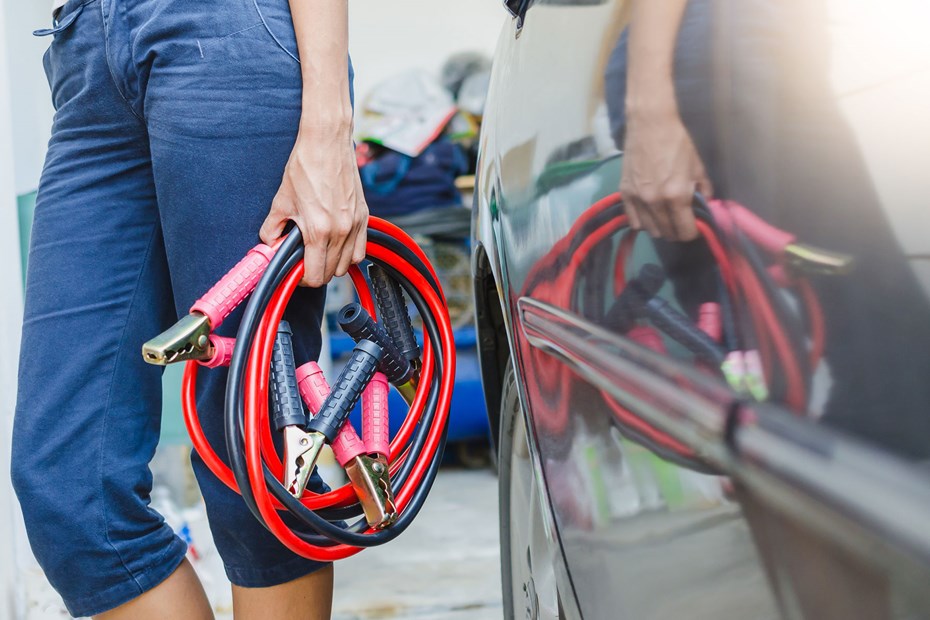A flat battery can easily derail your day, especially if you haven’t got a breakdown service, battery charger or booster pack to call upon. However, you don’t necessarily have to abandon your journey before it even begins. If you have a set of jump leads, or can find someone who does, you can jump start your car. And even if you can’t find any jump leads, a bump start can get your car running again.
However, if you’ve never had to jump or bump start a car before, it can be a bit confusing as to how you go about it. Even intimidating. But it’s actually quite easy and safe once you know how and, in this guide, we’re going to talk through every step of carrying out a jump start or bump start.
What do I need to jump start a car?
To jump start a car, you need a set of jump leads and a working car from which power can be drawn. The cables connect the battery in the working car to the flat battery in yours, giving your car the power needed to start its engine.
Ideally, you also need some gloves to stop your hands getting mucky, and safety glasses to protect your eyes. At the very least, remove any jewellery or loose clothing.
You should check the owner’s manual for both cars to find out if there’s a specific jump start procedure and any potential problems to be aware of. Carrying out some basic battery maintenance can help prevent needing to do a jump start in the first place.
How do I jump start a car?
Step one: Grab some jump leads and a working car
Locate your jump leads or procure some from elsewhere, and rope in a willing volunteer with a working car to help out.
Next, check the owner’s manual for both cars to ascertain the correct jump-starting procedure – you don’t want to inadvertently cause any damage.
Remember to check that the leads are undamaged, with no breaks in the sheath or corrosion on the clamps.
Step two: Basic preparations
Locate the battery in both cars. It’s usually under the bonnet in the engine bay but can be elsewhere – for instance, in some BMWs it’s behind a side panel in the boot. Consult the owner’s manual if needed.
Safely position the working car so that you can stretch the jump leads between the two batteries. You need some slack in them, so the working car may have to get close. Once that’s done, the handbrake should be on and the ignition off in both cars.
Inspect both batteries to make sure they’re undamaged and not leaking or bulging. If either of them is, they need replacing and aren’t suitable for jump starting.
Step three: Connecting the positive (red) jump lead
Locate the positive battery terminals on both cars. It’s marked with a positive (+) symbol. You can usually find it on the battery itself, maybe under a red cover. But it could also be separate from the battery, again under a red cover. Consult the owner’s manual if needed.
Take the red jump lead and use one of the clamps to attach it to the positive terminal on the working car. Then attach the other clamp to the positive terminal on the flat battery.
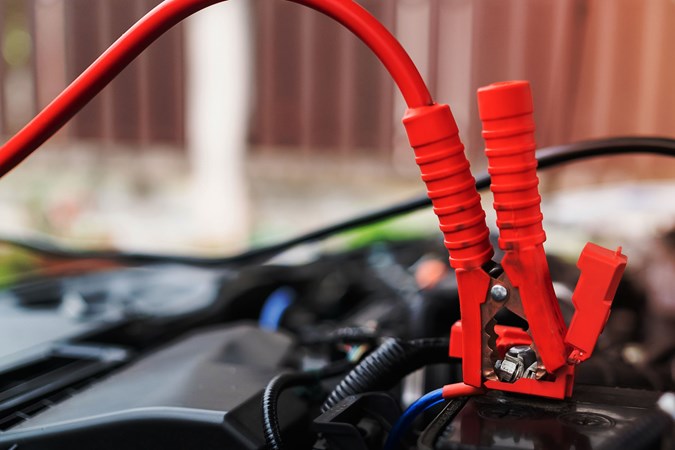
Step four: Connective the negative (black) jump lead
Take the black jump lead and clamp one end to the negative battery terminal – marked with a minus (-) symbol – on the working car.
Clamp the other end to an area of unpainted metal in the engine bay of your car. Some cars have a little metal post or a bit of metal specifically for jump starting. If not, avoid anything related to the fuel system or electronics. The exhaust manifold or suspension top mount will do, some cars have a little metal post or tab specifically for the job. The owner’s manual may offer advice.
Step five: Start the working car
Start the working car’s engine and let it run for a few minutes. Electricity flows between the two batteries as soon as you connect the leads and starting the working car prevents its battery going flat. If there is no life at all in your car’s battery, the working car may need running for up to ten minutes or so.
Step six: Attempt to start your car
Make sure you car’s handbrake is on and it’s in neutral or park. Attempt to start the car as normal. If all is well, it should burst into life relatively easily, maybe with a few turns of the starter motor (you’ll hear it spinning).
If the engine struggles to start or won’t start at all, wait another couple of minutes before trying again. If it still refuses, check the leads are securely connected. The battery terminals may also need a clean.
If you’ve done all that and there’s still no life, the flat battery may be completely dead. Or there’s some other problem that needs attention.
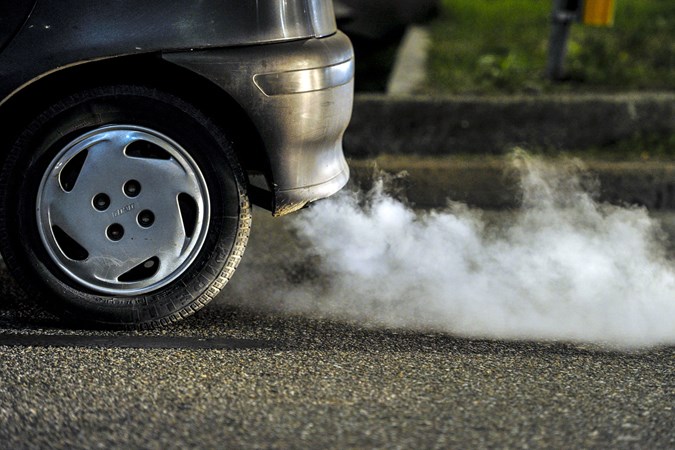
Step seven: Removing the leads
Once your car has been running for several minutes, turn off both cars’ engines and disconnect the negative lead, one end at a time. Then disconnect the positive lead, again one end at a time. Avoid touching the clamps to each other or on any metal on the cars. The clamps need to be released from the terminals quickly and cleanly. Don’t drag them off.
Step eight: Final checks
Before the other car leaves, try starting your car’s engine again. If it struggles, that’s a clue you need to get a new battery as soon as possible. If it won’t start, repeat the jump start procedure but leave the engines running longer.
Incidentally, if you replace your car’s battery but it still won’t start, there’s another problem that needs further investigation, possibly with the alternator.
Step nine: After a successful start
With your car’s engine now running, you need to drive for at least 30 minutes to build up enough charge in the battery to restart the car again later. If you can at all avoid it, don’t use any of the car’s electrical equipment such as the lights or air conditioning – they drain the battery. If you can’t go for a drive, leaving the car idling for 10 to 15 minutes should build up enough charge for one restart.
Using a jump pack
Using jump leads can be a palaver, especially finding a volunteer who will let you use their car for the jump start. Using a jump pack – also known as a booster pack – allows you to do a jump start single-handed.
The procedure for using a jump pack is exactly the same as carrying out a two-car jump start. But, rather than using the other car’s engine to provide electricity, the power comes from the pack’s built-in battery. Always read the pack’s instructions before use and remember to recharge it when you get home.
Note that there are battery boosters specifically designed for cars with bigger engines. If you have time, you could use a portable battery charger instead.
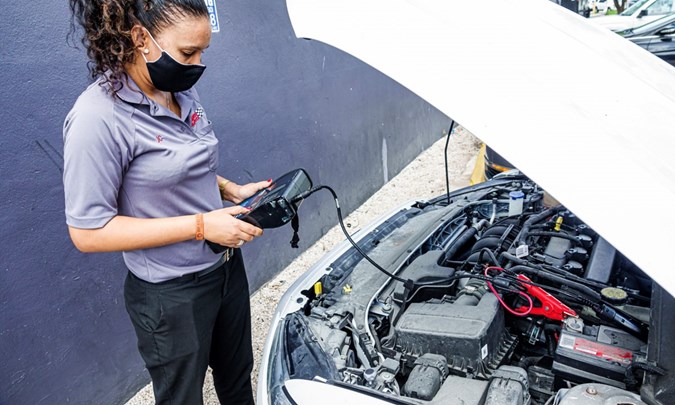
What about bump starting a car?
If you can’t locate any jump leads or a jump pack, or can’t call out a breakdown service, you have little option but to attempt a bump start – or a push start.
It can be a very effective technique, but it’s not without its pitfalls. You may need several volunteers to push your car, quite a lot of space, and you can only bump or push start a car with a clutch pedal. Diesel cars are more difficult to bump start, as well.
You also need at least some power in the car’s battery. If the dashboard lights come on, there should be enough juice to get the engine started. If the battery is stone dead, a bump start probably won’t revive it.

How do I bump start a car?
Step one: Check the manual
There may be a specific procedure for bump starting your car, so check the owner’s manual to find out. It may actually warn against attempting a bump start at all.
Step two: Plan your manoeuvre
You can actually carry out a bump start on your own by rolling your car down a slope. However, you need plenty of space. The car could get up to 5mph or more before the engine starts and you need room to stop.
If the engine doesn’t start, the brakes will still work (with a shove) but the car could take a lot longer to stop. The power steering won’t work without the engine, either.
Push starting the car is less potentially hazardous, but you need to find some volunteers to provide the muscle. Don’t try to push start a car on your own. Not to put too fine a point on it, people have died attempting to do so.
Step three: Ignition on
The car’s electrics need to be working to start the car, so turn the ignition on. If the dashboard lights up, there’s some juice in the battery and you should be able to get the car going. Turn off everything you don’t need – lights, air conditioning, infotainment system, etc.
You also need the ignition on to keep the steering lock off and it allows the engine to start during the bump or push start process.
Step four: Pick a gear
If there isn’t much space available to bump or push start the car, select first gear. If you have some more room, use second – the start will be smoother and more mechanically sympathetic.
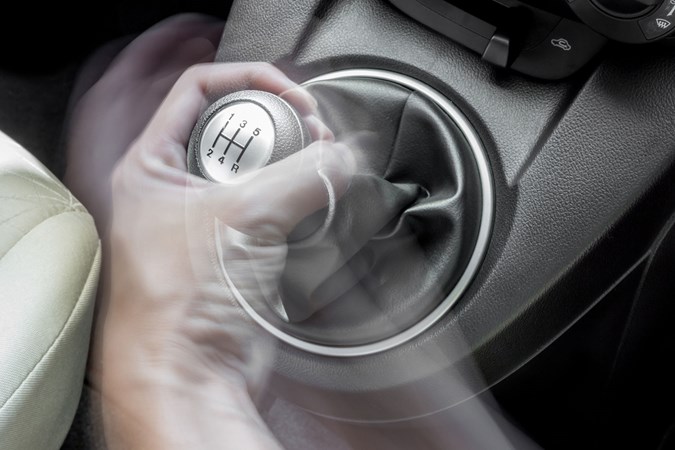
Step five: Get moving
Double check that the ignition is on, a gear is selected, and the way ahead is clear. Press the clutch pedal all the way down and release the parking brake. At that point your helpers should start pushing the car, or it’ll start rolling downhill.
Once the car is moving at a couple of miles an hour, quickly release the clutch pedal. At that point, the engine should burst into life. If it doesn’t, repeat the process as needed.
Once the engine has started, you need to jump back on the clutch to stop the engine stalling, then bring the car to a controlled stop.
Leave the engine running for a few minutes, then switch it off and restart it. Hopefully, it’ll do so without fuss. Now you need to leave it idling for about 15 minutes, or drive for 30 minutes to build the battery’s charge up. Don’t forget to thank your helpers!
If the engine struggles when you restart it, there may be another issue that requires investigation.
Step six: Try again if needed
You may need to attempt several bump or push-starts to get your car’s engine going. One possible cause of failure is a lack of speed.
You might find that, when you release the clutch, the car lurches aggressively but the engine doesn’t actually start. That’s because the car isn’t moving quickly enough to spark the engine back into life. Try again but wait for the car to build up a bit more speed.
If the car still refuses to start, there may be another issue that requires attention – but at least you gave it a shot before resorting to a breakdown service.
Are there any other tricks that might help?
It is possible to bump start a car by towing it behind another vehicle. Once the two cars are connected by a tow rope, the process of getting the car going is exactly the same as for a bump start.
However, attempting a tow start can be rather hazardous. The tow car will have to pull away very slowly and smoothly, and you need to co-ordinate with its driver to make sure you don’t end up driving into the back of their car.
How to connect jump leads
First, you need to locate your car’s battery. Next, take the red clamp and attach it to the positive battery terminal, then attach the black clamp to the negative terminal. Then repeat those steps on the car you’re getting a jump start from. When taking the leads off, remove the black clamp first, then the red clamp at one end and repeat at the other. Scroll back up the page to read a more in-depth explanation of the process.
Just so you know, we may receive a commission or other compensation from the links on this website - read why you should trust us.


